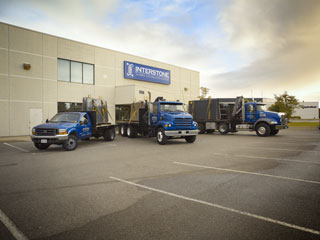 Limestone
Limestone flooring's virtues
have long been known. The Great Pyramid of Giza, one of the seven wonders of
the ancient world, is covered entirely in limestone. Here in Canada, many
public buildings have been constructed in the sedimentary stone. In fact, it
was such a popular building material in Kingston, Ontario, that it is known as
The Limestone City. It is easy to cut into blocks or carve, it's long lasting,
and it stands up well to the elements, however, limestone's cost renders it
impractical for most modern buildings.
Adding to its beauty are the naturally occurring idiosyncrasies that
have developed in the rock's formation. Most limestone is composed of grains –
skeletal fragments of marine organisms, including shells and coral. Because of
impurities, such as sand, iron and organic remains, the limestone takes on
different colours – and this is one of the biggest reasons for its increasing
popularity beyond the exteriors of buildings.
Limestone is now a highly sought-after flooring material. Tiles made
from limestone have great durability, a varied appearance and are low
maintenance. It is chameleon-like in its
ability to complement both traditional and modern styles. Because it has a
diverse range of colours, textures and patterns, it can match most colour
schemes, and it works well in any room of the house.
Because it is a softer stone, limestone is less suitable for very heavy
traffic floor areas.
Calculate the Costs
Limestone tiles are expensive, but they will pay off the initial in
investment by increasing the resale value of your home. There are, however, a
number of extra costs, beyond that of the stone, which you should be aware of in advance of
your purchase.
-
Furniture removal and replacement – some retailers charge for this
-
Demolition, removal and disposal of the old floor covering
-
Preparation of a sub-floor may be necessary
-
Product delivery may not be included in the "cost per square foot”
purchase price
-
Installation fee
-
Financing options.
Maintenance of Limestone Tiles
Abrasives – both natural and in cleaning products – can be tough on tiles. Sand, grit
and dirt can damage natural stone surfaces. Damp mopping a
stone floor with soap instead of
detergent is advised. Avoid products containing lemon juice, vinegar or other
acids on limestone, as well as abrasive and ammonia-based cleaners. They will
dull the floor's lustre.
Who Knows Your Floors Best?
There are many distributers and installers of
limestone tiles. The best plan is
to seek out specialists who have a track record and a focus on the kind of
stone you want to install. There are dealers who know wood flooring – and there
are those who understand stone. The latter – especially with a complex and
varied material like limestone – have specialized knowledge that you can draw
upon. Stone flooring is not a "do it yourself” operation so look for a family
company with plenty of installation experience. They will have the best
incentives to make you a happy customer.
Limestone
tiles are an expensive choice – but rewarding, both visually and financially.
Just make sure you get the right help!